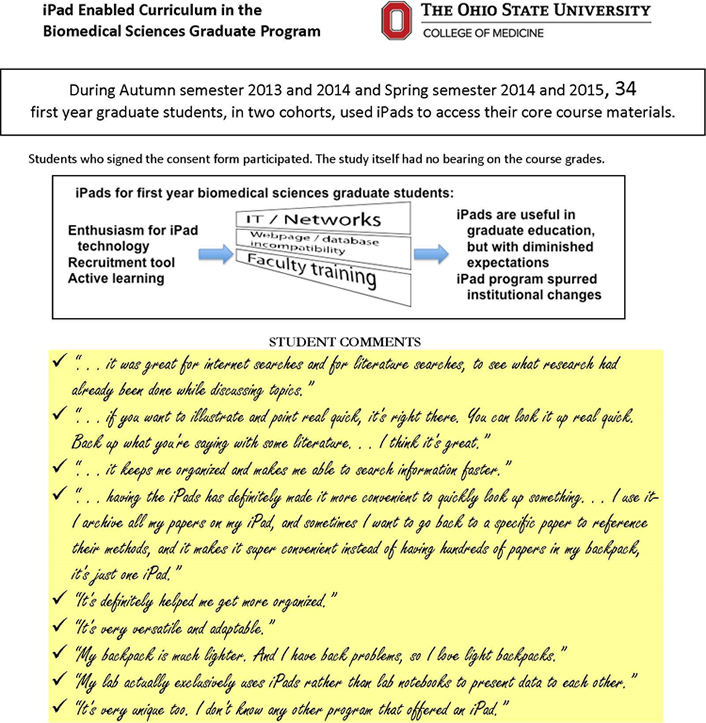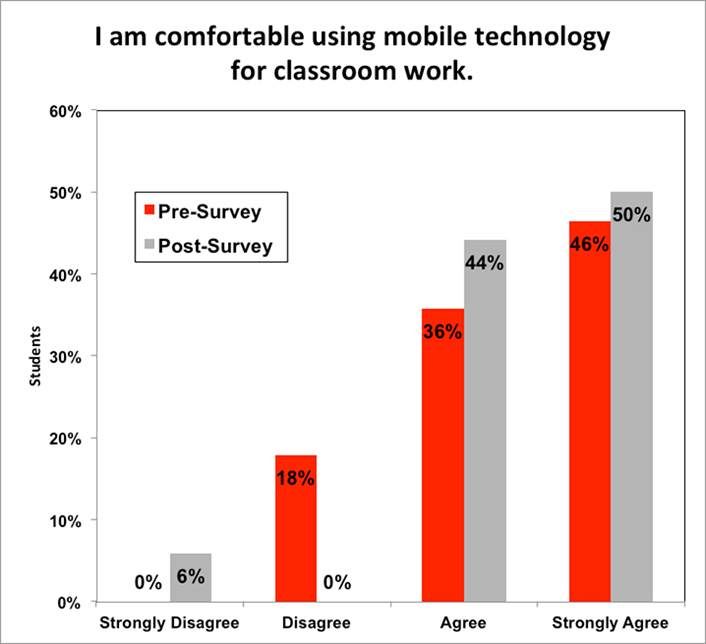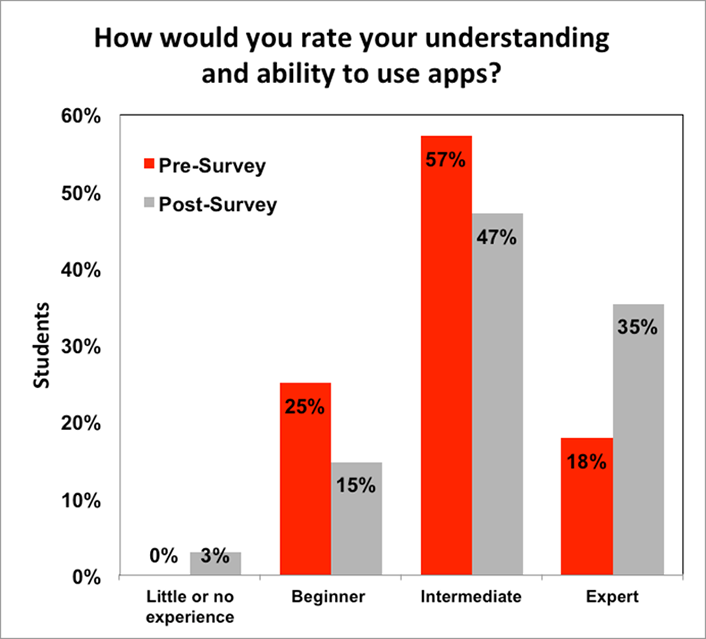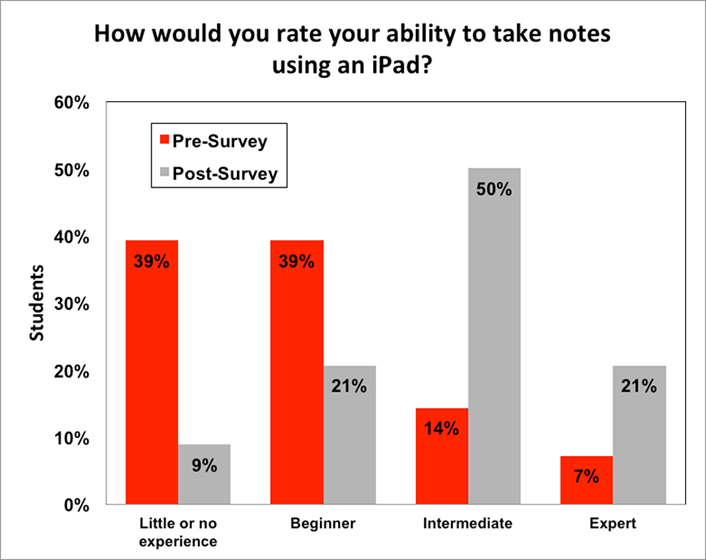Key Takeaways
- This case study examined student satisfaction with Apple iPad technology in the Biomedical Sciences graduate school setting at The Ohio State University College of Medicine.
- The iPad proved to be an effective recruitment tool and improved the educational experience by engaging students in active learning: note taking, collaborative work, student organization, and information retrieval.
- Goals for the iPad as a learning tool were only partially met because of technical issues that diminished its effectiveness, subsequently spurring institutional changes in network management that ameliorated some of the limitations encountered.
- Overall, the adoption of iPads enhanced the students’ educational experience.

Limited educational research addresses use of the iPad in the classroom,1 but increasingly many people are adopting tablet technology. For example, the percentage of American adults who own tablets almost doubled over the 2011 holiday season, from 10 percent to 19 percent, as did the ownership of e-book readers.2 Current research indicates potential for the iPad to serve as a teaching tool because of its light weight, high connectivity, and functionality with both typed and hand-written note taking.3
Use of the iPad instead of the traditional paper-based, lecture style of note taking changes the classroom environment to focus more on problem solving and collaboration, instead of on the all-knowing professor.4 This aspect fits with the goal of the Biomedical Sciences Graduate Program at The Ohio State University College of Medicine — to encourage active learning in the classroom, where students seek out information to solve problems rather than having it "spoon fed" to them.
In this case study, we evaluated whether the use of iPads improved students' educational experience at the graduate school level.
Methodology
In spring 2012, members of the Learning Technology team at the Office of the Chief Information Officer partnered with Apple to launch the Digital First Initiative, which introduced innovative and mobile technology to the university in order to change the way we teach, learn, and conduct research at Ohio State.
Apple's education ecosystem has some persuasive reasons to select iPad hardware. Specifically, iTunes U, Apple TVs, and iBooks Author each provide easy-to-use tools that can be integrated into educational environments. In addition, the consumer popularity of the iPhone and iPad have made Apple's hardware a cultural icon, and most students and faculty members have had at least general exposure to the iPad operating system, thus making adoption and use straightforward.
As part of Ohio State's digital initiative, the Biomedical Sciences Graduate Program applied for and was selected as the first recipient of the Digital First Impact Grant in summer 2013, giving the program access to Office of Distance Education and eLearning staff expertise, financial resources, and the opportunity to integrate mobile technology via the iPad into the first-year graduate curriculum. After grant funding ended, the initial success of the project convinced the graduate program to cover the cost of iPads in its budget.
As part of the Digital First Impact Grant, the research for this project was conducted by the Ohio State’s College of Medicine in partnership with the Office of Distance Education and eLearning. The results are reported as part of a larger snapshot of mobile learning and educational technology use. This study will help Ohio State determine appropriate avenues for integrating digital pedagogy and processes into enterprise-level services and support models. Simply stated, our goal was to streamline and enhance the student learning experience via technology. Course delivery via iTunes U, instant Internet researching via mobile browsing, note taking, paper reduction, wireless collaboration, and enhanced communication strategies were all goals around integrating the iPad for mobile learning. This study focused on the student experience with Apple iPad technology in the graduate school setting and also provides a high-level overview of iPad use in the classroom.
The sample set of 34 included two cohorts of first-year graduate students newly enrolled in the Biomedical Sciences Graduate Program in the College of Medicine at The Ohio State University. All first-year students were given iPads (figure 1) to borrow during their graduate careers, and all of them participated in the study, although they had the opportunity to opt out and still use the iPads without penalty. Participants were over the age of 18 and enrolled in the required core courses during autumn semester 2013 through spring semester 2015. The study itself had no bearing on the course grades.

Figure 1. Distribution of iPads by Amy Lahmers and Jeffrey Parvin
Before each autumn semester, students took a pre-survey self-reporting their level of comfort and familiarity with iPad technology. After completion of the spring semester, students repeated the assessment in a post-survey self-reporting their level of comfort with the technology after two semesters of use. Both the pre- and post-surveys captured self-reported perceptions rather than formal, objective measurements of capability and effective use. Participants from both years were asked to participate in a spring semester focus group discussion with structured open-ended questions to gather data on positive and negative aspects of their interaction with the iPad in the academic setting.
Students received an overview of the iPad in a training session. iTunes U provided all course materials. Students were also encouraged to access the OSU Digital First Initiative's iPads in Education iTunes U course, which provided information and resources regarding apps, device management, and training videos.
We hoped that students would use their iPad for note taking via Notability, developing presentations via Keynote, word processing via Pages, lecture capture via Explain Everything, and lab notebooks using Evernote. Each of these mobile apps was provided during the iPad training sessions. We encouraged the students to use the iPad for classroom assignments and as they saw fit for their own day-to-day personal use. We also asked them to experiment with ways the device could be used to enhance the curriculum.
Because the pre- and post-survey results for the two years were similar, we combined them for reporting purposes.
Results
While students entered the graduate program with a certain level of proficiency (65 percent of students Agreed or Strongly Agreed that they had used mobile technology to access materials in a prior course), their perceived skill level had increased at the end of the academic year, with 76 percent of students rating themselves as Intermediate or Expert-level iPad users compared to 39 percent in the pre-survey. By comparison, 100 percent of students rated themselves as Intermediate or Expert laptop users on both the pre- and post-surveys.
Comfort with the iPad increased the longer students used it: 82 percent of students on the pre-survey and 94 percent on the post-survey indicated they Agree or Strongly Agree to the statement, "I am comfortable using mobile technology for classroom work" (figure 2).

Figure 2. Increases in self-reported comfort with iPads
Similarly, proficiency with mobile apps increased during the course of the year (figure 3). Mobile apps the students reported using were Notability, Socrative (a response system), Adobe Reader, Buckeye Box (cloud storage), iMole, EndNote, LabCap, and Evernote. Many students found that an external keyboard facilitated use of the iPads for note taking.

Figure 3. Increases in self-reported proficiency with apps
Perhaps the most significant change in survey results occurred in the area of note taking (figure 4). Specifically, 71 percent of students rated themselves as Intermediate or Expert note takers in the post-survey, compared to 21 percent in the pre-survey.

Figure 4. Increases in self-reported note-taking ability
Overall, students indicated that they found the iPads useful in their educational pursuits. In the post-survey, 91 percent — vs. 82 percent in the pre-survey — indicated that they have the skills necessary to use cloud technology as a tool in their coursework. All students in both the pre- and post-surveys chose Agree or Strongly Agree to the statement, "I have the skills necessary to research new concepts using iPad technology." On both the pre- and post-surveys, all but one student indicated that they use the Internet Often or Constantly for classroom assignments or lab work. In addition, in the focus group discussions, students commented that the iPad made their backpack lighter, helped them stay organized, and was convenient for note taking, collaborative work with their peers, researching information online, and keeping their coursework in one central location.
iPads proved helpful for specific aspects of the graduate school curriculum. Reading of the scientific literature was facilitated by the distribution of PDFs of journal articles and the use of Apple TV to project from the iPads. As part of discussion-based classes, different students could take control of the projector in order to share what was on their iPad with the class.
The focus groups revealed some challenges using the iPad. The IT infrastructure for the iPad project resided in the Medical Center, a strictly Microsoft infrastructure using active directory, and during the length of the iPad program it switched encryption schemes twice. This network infrastructure was incompatible with iPads and the use of Apple TV. We initially bypassed the network issues by using consumer-grade routers and Apple TVs with adapters hooked up to the projectors, but while this arrangement enabled iPad use with the Apple TV, difficulty connecting to the Internet and sharing files frustrated the students. In the second year of iPad use, the Medical Center network changed, making the use of Apple TV and accessing the Internet more convenient.
Even with the network improvements, multitasking and switching between the PDF viewer and web browser could be difficult and slowed down classes as we waited for websites to appear. Because of other systemic issues using iPads in a biomedical sciences graduate school setting and because many websites and databases did not work well with iPads, students also needed laptops.
The students' perceptions of the iPad's value as an educational tool decreased during the academic year (figure 5). In the pre-survey, 47 percent of the students indicated they were quite confident or positive that the iPad was the best tool to enhance their learning in the classroom. In contrast, in the post-survey, after students had become experienced in using the iPad and dealing with its surrounding technical issues, the number of students who reported Quite Confident or Positive that the iPad was the best educational tool declined to 38 percent. Indeed, 9 percent indicated in the post-survey that they lacked confidence in the iPad as an educational tool.

Figure 5. Decreases in self-reported confidence in iPad use
Lessons Learned
Faculty and students were not as disappointed with the iPads and the technology as they were with the network incompatibilities. The challenges encountered with iPad use have since led the Medical Center to change from an entirely Microsoft network to a hybrid of Apple and Microsoft. Furthermore, Apple TVs have been fully integrated into both the network and individual room projectors, allowing faculty members to easily interface with their iPads without additional equipment. Since the conclusion of our study, technical and customer service teams have increased support for iPads and general connectivity issues, taking steps toward a fully functional cross-platform environment. These technical advances set the stage for a shift in how the Medical Center currently implements, updates, and supports new technologies.
The implementation of a successful iPad project requires adequate faculty training and adequate staff support. We held three half-day training sessions for teaching faculty where educational technologists covered how to create and deploy iPad-friendly instructional materials. Educational technologists also made themselves available to meet with individual faculty members to discuss their specific course needs. Faculty support for the project has been strong, although in hindsight we could have allotted more time for faculty members to prepare for the implementation. Staff support was also important in implementing the program, as we had a central office staff member who assisted teaching faculty members with the creation of iTunes U courses as well as the creation of several iBooks.
Conclusions
From the two-year experience of equipping all our first-year graduate students with iPads, we found many advantages of an iPad-enabled curriculum in our graduate program, but challenges remained. The main advantages included
- a portable device with constant access to the web while on campus;
- consistency with the educational goal of active learning;
- excitement among our students to receive an iPad;
- increased enthusiasm for the graduate program that benefited recruitment efforts; and
- a sense of newness, with the deployment of this technology enhancing the graduate student experience.
The challenges included
- IT network incompatibilities with the technology;
- websites and databases not always iPad compliant; and
- the need for faculty to learn how to use the iPads for the technology to reach its full potential.
Overall, the adoption of iPads in graduate education enhanced the educational experience by increasing classroom connectivity, promoting engagement, and putting a wealth of new teaching and learning tools at the fingertips of students and faculty.
At The Ohio State University Biomedical Sciences Graduate Program, we will continue to provide iPads to our entering students and foster high enthusiasm for the use of mobile technology in graduate education.
Acknowledgments
This work was supported by the Digital First Impact Grant Initiative within the OSU Office of Distance Education and eLearning; NIH Award Number UL1TR001070 from the National Center for Advancing Translational Sciences; and the Howard Hughes Medical Institute Med into Grad Dissemination Award. The content is solely the responsibility of the authors and does not necessarily represent the official views of the National Center for Advancing Translational Sciences or the National Institutes of Health.
Notes
- Mary Ann Gawelek, Mary Spataro, and Phil Komarny, "Mobile perspectives: On iPads why mobile?" EDUCAUSE Review, Vol. 46, No. 2 (March/April 2011): 28–32.
- Lee Rainie, Tablet and E-book Reader Ownership Nearly Double over the Holiday Gift-Giving Period, Pew Internet and American Life Project, Jan. 23, 2012.
- Colin F. Mang and Leslie J. Wardley, "Effective Adoption of Tablets in Post-Secondary Education: Recommendations Based on a Trial of iPads in University Classes," Journal Of Information Technology Education: Innovations in Practice, Vol. 11, No. 1 (2012): 11301–11317.
- Jodie Wakefield and Dennie Smith, "From Socrates to Satellites: iPad Learning in an Undergraduate Course," Creative Education, Vol. 3, 2012: 643–648.
Amy Lahmers serves as the administrative director of the Biomedical Sciences Graduate Program, NIH Discovery Postbaccalaureate Research Education Program, and Howard Hughes Medical Institute Med Into Grad Scholars Program in the College of Medicine at The Ohio State University. She has worked in college academic affairs administration for 15 years. Ms. Lahmers received an MS in College Student Personnel from Miami University and a certificate in Leadership in Human Service Management from The Ohio State University. In addition to this research study, she has completed research on the use of time and academic performance of college students. She is interested in enhancing student learning using the latest educational technology.
Cory Tressler is the associate director of learning programs in the Office of Distance Education and eLearning at The Ohio State University. He manages the development and utilization of iTunes U courses at Ohio State, assists with mobile learning projects, coordinates the development of online undergraduate courses, and connects K–12 schools throughout Ohio with learning opportunities from Ohio State. Tressler has more than 10 years of experience in education as a teacher and administrator and is an advocate for increasing students' access to engaging educational experiences. He earned a MAT in Education from the University of South Carolina and is currently pursuing a PhD in Educational Studies from The Ohio State University.
Tim Yulish is the director of Research Operations-IT in the College of Medicine's Office of Research at The Ohio State University. He initiates and oversees projects in research operations, reporting, and technology implementation with the ultimate objects of enabling faculty, staff, and students to more effectively conduct research. Yulish has more than 10 years of project management and customer service experience. He leverages his project management and technological background to find efficiencies and streamline processes. Yulish received his MBA from Ohio University and is certified in Lean Six Sigma.
Daniel M. Clinchot is vice dean for Education in the College of Medicine at The Ohio State University.
Joanna L. Groden is vice dean for Research and co-director of the Biomedical Sciences Graduate Program in the College of Medicine at The Ohio State University.
Jeffrey Parvin is Louis Levy Professor for Cancer, associate dean for Graduate Studies, and co-director of the Biomedical Sciences Graduate Program in the College of Medicine at The Ohio State University.
© 2015 Amy K. Lahmers, Cory Tressler, Tim Yulish, Daniel M. Clinchot, Joanna L. Groden, and Jeffrey D. Parvin. This EDUCAUSE Review article is licensed under Creative Commons BY-NC-ND 4.0 International.
